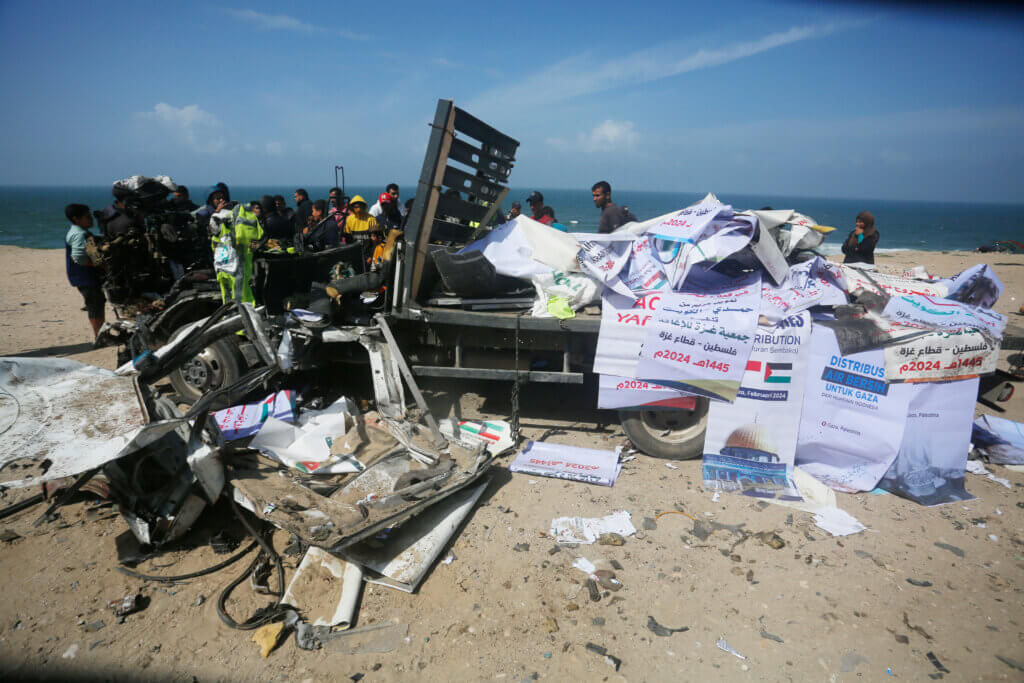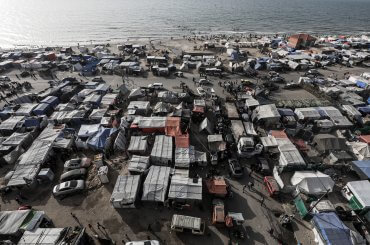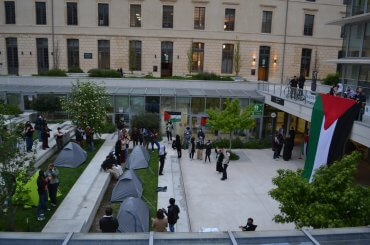In less than a week, Israel has committed several massacres against the hungry. On Sunday, March 3, Israel bombed an aid convoy, killing 7 people. But the most infamous incident was on February 29, in what has come to be known as the “flour massacre” on al-Rashid Street, near the Nabulsi roundabout west of Gaza City. Israel killed over 115 starving people on that day, while over 750 people were injured.
Faris Elewya, 52, a resident of the Sha’af area east of Gaza City, told Mondoweiss what he saw. When he left his house, only two reasons justified braving the warzone that was northern Gaza. The first was the image of his starving family, made up of five children, and the second was the hope of returning with some flour to show for his trouble.
“I left the house not knowing what day it was,” he said. “And I don’t know what day it is now as I talk to you.”
“I had heard that anyone who goes to the Nabulsi area west of Gaza can find the aid trucks passing through the north. I didn’t hesitate. Even if I was taking a risk, it’s better than watching my family starve to death,” he continued.
After walking for three hours, he reached the Nabulsi roundabout, where he found throngs of people already waiting for the convoy to arrive. There was hardly any room left for people to move, as some had brought their entire families with them to try and carry as much aid as they could get their hands on. Some had set up camp in the area the night before — the Nabulsi roundabout has become the first stop for any aid convoy arriving in the north — and had gathered stray firewood to keep warm as they waited.
Near the roundabout was an Israeli checkpoint guarded by several military vehicles. The army had placed its checkpoints at Gaza City’s two main entrances, the Nabulsi roundabout on Gaza’s coastline, and another site near the Kuwaiti roundabout on Salah al-Din Street. This convoy’s designated route passed through the coastal road.
“People gathered in the vicinity of the vehicles, given their proximity to the gathering point,” Eleywa said. “But no one wanted to do anything to the tanks or the soldiers. Everyone there had only one objective: to find food for their families.”
“Usually, people receive aid by taking it off the trucks that pass through,” he added. “But this time, when the trucks entered, people swarmed the trucks in hysteria because of the famine.”
Eleywa said that hundreds of people were pushed through the checkpoint to the southern side due to the chaos from the pushing and shoving.
“Suddenly, hundreds of people found themselves on the south side of the checkpoint, with everyone else on the north side,” he explained. “The checkpoint split the crowd in two.”
When this happened, the soldiers prevented those who had entered the checkpoint from passing back to the northern side, opening fire on the crowd.
“Those who were able to make it back to the northern side managed to do so by crawling and hiding,” Eleywa continued.
International observers, including UN officials, visited the injured survivors at al-Shifa’ Hospital, confirming that the majority of wounds from the hundreds of injured people were due to live ammunition.
‘The hunger eats away at our stomachs’
The aid that enters northern Gaza is stained with blood, as Israel’s use of food as a weapon of war reaches new heights. But people still brave these conditions because they have no other choice.
“It’s been forty days, and none of my children has seen the sight of bread,” Eleywa said. “I and two of my older sons spend the entire day searching for food, and by the end of the day, we come up short and return home together. The whole family sits together in the night’s darkness. The hunger eats away at our stomachs.”
“Nothing is worse than that,” Eleywa remarked emphatically. “The danger we face in trying to get flour is nothing compared to how we feel on those nights.”
But instead of returning home with food in tow that day, he returned frightened and shaking, hardly believing that he was able to survive the bullets that had whizzed past his body and hit others beside him.
The last time Faris Eleywa ate with his family was two days before speaking to Mondoweiss. “We had received two cans of fava beans,” he explained. “My wife put them on a plate, and we ate them plain, without bread.”
“With the blink of an eye, the plate was gone,” he said ruefully. “The food was so little that it vanished in seconds.”
‘I grabbed the food and crawled through the dirt’
The people of northern Gaza live in unimaginable conditions. Hunger and thirst are quickly threatening to be more dangerous to people than the incessant airstrikes. In such times, a family that hasn’t eaten in three days is far from rare. You are even likely to find some who haven’t eaten for a week.
Ahmad Imteiz, 28, lived with his wife and three children in the Zeiytoun area but fled to the Rimal neighborhood after their neighborhood was re-invaded by Israeli ground forces. He was also present during the Nabulsi roundabout incident and was able to return to his home carrying some food for his family.
“I don’t know how to explain to my children that we don’t have food.”
Ahmad Imteiz
“I got to the Nabulsi roundabout at 10 a.m.,” Imteiz told Mondoweiss. “I waited for the convoys as the number of people there swelled to the thousands.”
“Then a few trucks arrived. One truck was carrying canned foods. Another was carrying frozen chicken. People rushed the trucks before they even reached the Israeli checkpoint,” he recounted.
Most of the people surrounding the trucks were shot dead or injured. Ahmad was able to return home carrying four cans of fava beans and a single chicken he had managed to grab.
“I grabbed the food and crawled through the dirt,” Ahmad explained. “I crawled for a very long time. I crossed almost a kilometer until I reached a safer place where I could get up and run.”
Ahmad did not hesitate when asked whether the trek was worth it. “Yes,” he answered. “To save my hungry children, yes.”
“Our lives must have become so meaningless and cheap for so many people to die this way,” he observed bitterly. “Children die, women die, families die. All from hunger.”
“I don’t know how to explain to my children that we don’t have food,” Ahmad said. “I don’t know how to face them and tell them they will continue to go hungry. I would rather face death than have to tell them that.”



What a sad and tragic situation. They were deliberately starved by Israel (supported by the US, UK, and EU nations who stopped the aid to UNRWA), and now as they suffer and are dying as a consequence, they have to go through this hell on earth, which seems sadistic, to say the least. No human being capable of feeling compassion, and has any human kindness, can condone the cruelty shown by the Occupier towards the victims. They seem to have mastered the art of Cruelty.
There are many conflicting news reports as to how and why this terrible massacre happened, and since the UN and their agencies have denied being involved in these aid trucks sent there, we have to wonder who was driving those trucks, where they came from, and if the claim by a victim that he felt it was a “trap”, has some truth to it. Let the investigations begin.
With so many similar incidents even afterwards, we must conclude THIS is the apartheid nation’s cruel policy – to shoot at starving people when they rush to the food trucks. There is an obvious pattern here, which the evil forces hope the world does not notice.
Watch the Majority Report cover Christian Amanpour question Lying Mark Regev about it. He is a disgusting liar, and a not so artful dodger. All their so called spokespeople usually are masters at lying with either a straight face, or they are able to speak with that indignant look, while their lies are sometimes met with instant fact checking.
https://www.youtube.com/watch?v=YdmFxjJu45A